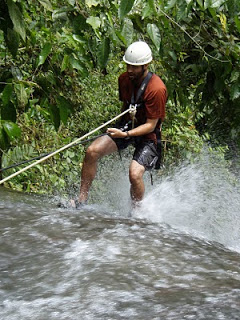 Waterfall rappelling is easily one of the most photographed activities we have here at Outward Bound Costa Rica. When editors of local newspapers decide to publish something about one of our alumni in their “Hometown Heroes” sections, they will inevitably choose the photo of the student waterfall rappelling over any others we submit.
Waterfall rappelling is easily one of the most photographed activities we have here at Outward Bound Costa Rica. When editors of local newspapers decide to publish something about one of our alumni in their “Hometown Heroes” sections, they will inevitably choose the photo of the student waterfall rappelling over any others we submit.
This activity mixes both a true challenge with a defining beauty mark of Costa Rica, the waterfall. It’s only natural that students love getting photos from the day they rappelled in a Costa Rican rainforest amidst rushing water.
But in the moment students are about to descend, their emotions aren’t as “beautiful” as the photos being taken of them. Most times groups consist of 7-15 students. Therefore, the wait at the top for others to descend in front of you one-by-one can be quite nerve-wracking. Especially as a first-timer, you try to pay close attention – over the loud rushing water, of course – to the instructors who are repetatively teaching the technique to each student ready to begin rappelling.
Never fear. Not only are your instructors highly skilled at setting up the ropes and carabiners, but these instructions aren’t complicated:
Basics:
- Wear shoes with grips on the bottom
- Legs in front of you (as if you were sitting in a lounge chair)
- Wide feet to maintain balance
- Your “break hand” (the one clutched to the rope) stays close to your hip to slow the descent
- Keep feet the same height as your hips
- Lean back as much as possible (as if you were “standing” on the vertical wall)

Students follow these ten steps to complete a rappel:
- Put on your helmet and harness; your instructor will tighten them accordingly
- While waiting for your turn to descend, secure long hair and loose clothing against your body and don’t alter any of the safety equipment
- Allow your instructor to set up the ropes (both primary and saftey ropes) through your carabiners and harness
- Your instructor directs you to a rappelling position to begin descending
- Put your “break hand” (your strong hand) on the rope hanging on your strong side, and your other hand (a.k.a. your “free hand”) can hold on to the harness near your navel; the free hand plays no part in helping you rappel
- Lean back, as if you were lying in a lounge chair, while keeping feet wide
- Begin stepping backwards over the edge, keeping your shoulders back
- Rappelling down the waterfall is a combination of shifting your weight from one foot to the other while keeping your feet wide for balance and your shoulders back
- To break, the “break hand” holds the rope as close to the back of your hip as possible; conversly, you can descend faster by lifting this hand away from your hips and out to the side; the instructor at the top of the waterfall is in charge of your safety rope (to aid descent and breaking if needed)
- The instructor at the bottom helps detach the ropes once you have reached the bottom
That, and you look good.